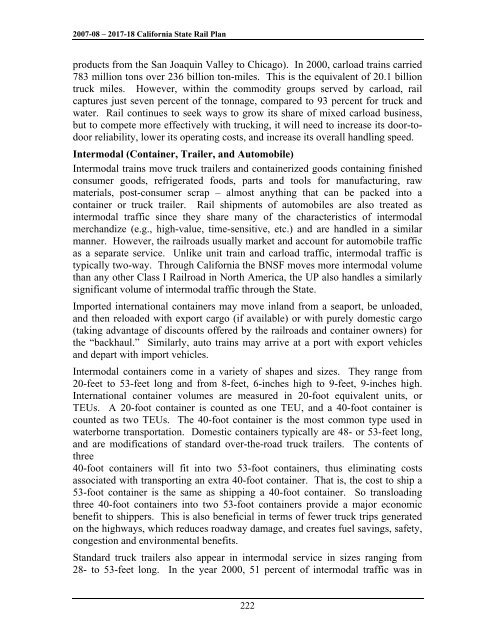California State Rail Plan 2007-08 to 2017-18
California State Rail Plan 2007-08 to 2017-18
California State Rail Plan 2007-08 to 2017-18
- No tags were found...
You also want an ePaper? Increase the reach of your titles
YUMPU automatically turns print PDFs into web optimized ePapers that Google loves.
<strong>2007</strong>-<strong>08</strong> – <strong>2017</strong>-<strong>18</strong> <strong>California</strong> <strong>State</strong> <strong>Rail</strong> <strong>Plan</strong>products from the San Joaquin Valley <strong>to</strong> Chicago). In 2000, carload trains carried783 million <strong>to</strong>ns over 236 billion <strong>to</strong>n-miles. This is the equivalent of 20.1 billiontruck miles. However, within the commodity groups served by carload, railcaptures just seven percent of the <strong>to</strong>nnage, compared <strong>to</strong> 93 percent for truck andwater. <strong>Rail</strong> continues <strong>to</strong> seek ways <strong>to</strong> grow its share of mixed carload business,but <strong>to</strong> compete more effectively with trucking, it will need <strong>to</strong> increase its door-<strong>to</strong>doorreliability, lower its operating costs, and increase its overall handling speed.Intermodal (Container, Trailer, and Au<strong>to</strong>mobile)Intermodal trains move truck trailers and containerized goods containing finishedconsumer goods, refrigerated foods, parts and <strong>to</strong>ols for manufacturing, rawmaterials, post-consumer scrap – almost anything that can be packed in<strong>to</strong> acontainer or truck trailer. <strong>Rail</strong> shipments of au<strong>to</strong>mobiles are also treated asintermodal traffic since they share many of the characteristics of intermodalmerchandize (e.g., high-value, time-sensitive, etc.) and are handled in a similarmanner. However, the railroads usually market and account for au<strong>to</strong>mobile trafficas a separate service. Unlike unit train and carload traffic, intermodal traffic istypically two-way. Through <strong>California</strong> the BNSF moves more intermodal volumethan any other Class I <strong>Rail</strong>road in North America, the UP also handles a similarlysignificant volume of intermodal traffic through the <strong>State</strong>.Imported international containers may move inland from a seaport, be unloaded,and then reloaded with export cargo (if available) or with purely domestic cargo(taking advantage of discounts offered by the railroads and container owners) forthe “backhaul.” Similarly, au<strong>to</strong> trains may arrive at a port with export vehiclesand depart with import vehicles.Intermodal containers come in a variety of shapes and sizes. They range from20-feet <strong>to</strong> 53-feet long and from 8-feet, 6-inches high <strong>to</strong> 9-feet, 9-inches high.International container volumes are measured in 20-foot equivalent units, orTEUs. A 20-foot container is counted as one TEU, and a 40-foot container iscounted as two TEUs. The 40-foot container is the most common type used inwaterborne transportation. Domestic containers typically are 48- or 53-feet long,and are modifications of standard over-the-road truck trailers. The contents ofthree40-foot containers will fit in<strong>to</strong> two 53-foot containers, thus eliminating costsassociated with transporting an extra 40-foot container. That is, the cost <strong>to</strong> ship a53-foot container is the same as shipping a 40-foot container. So transloadingthree 40-foot containers in<strong>to</strong> two 53-foot containers provide a major economicbenefit <strong>to</strong> shippers. This is also beneficial in terms of fewer truck trips generatedon the highways, which reduces roadway damage, and creates fuel savings, safety,congestion and environmental benefits.Standard truck trailers also appear in intermodal service in sizes ranging from28- <strong>to</strong> 53-feet long. In the year 2000, 51 percent of intermodal traffic was in222













